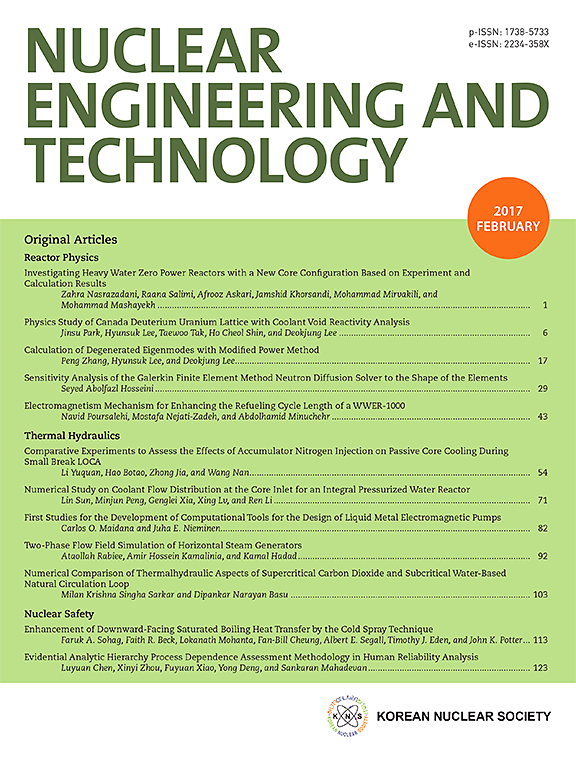利用基于 7Li(p,n)7Be 反应的中子射线成像设备进行砖块无损模拟测试的方法
IF 2.6
3区 工程技术
Q1 NUCLEAR SCIENCE & TECHNOLOGY
引用次数: 0
摘要
非破坏性中子射线照相术(NR)用于检查各种结构材料的内部组成,一直是广泛研究的重点。本手稿利用非破坏性测试生成三种不同砖结构材料(玻璃砖、镁铬砖和铅砖)的三维射线照片,以评估它们承受源发射的快中子和伽马射线的能力。当需要热谱或表谱中子时,使用锂靶上的 2.8 MeV 质子束模拟了加速器的最佳组合。所介绍的设备同时测试了热中子和快中子射线照相术。这项研究考察了各种孔径和准直器长度。研究发现,采用特殊的快中子滤波器可以显著提高热中子含量(TNC),而对热中子通量的影响却微乎其微。对于快中子射线照相,研究评估了几何不清晰度、快中子通量和到达物体的未碰撞快中子百分比等参数。来自放射源的中子和光子都被用来检测玻璃砖的故障。本文章由计算机程序翻译,如有差异,请以英文原文为准。
Bricks non-destructive simulation testing method utilizing neutron radiography facility based on a 7Li(p,n)7Be reaction
The evaluation of non-destructive neutron radiography (NR) for examining the internal composition of various structural materials, has been the focus of extensive research. This manuscript uses non-destructive testing to generate three-dimensional radiographs of three different brick structural materials: glass block, magnesia-chrome, and lead to evaluate their capability to withstand fast neutrons and gammas emitted from a source. When neutrons with thermal or epithermal spectrum are required, the optimum combination for an accelerator was simulated using a 2.8 MeV proton beam on a lithium target. The presented facility tested both thermal and fast neutron radiography. This study examined various aperture diameters and collimator lengths. It found that implementing a special fast neutron filter significantly increased the thermal neutron content (TNC) with minimal impact on the thermal neutron flux. For fast neutron radiography, the study evaluated parameters such as geometric unsharpness, fast neutron flux, and the percentage of the uncollided fast neutron reaching the object. Both neutrons and photons from the source were used to inspect faults in a glass brick.
求助全文
通过发布文献求助,成功后即可免费获取论文全文。
去求助
来源期刊

Nuclear Engineering and Technology
工程技术-核科学技术
CiteScore
4.80
自引率
7.40%
发文量
431
审稿时长
3.5 months
期刊介绍:
Nuclear Engineering and Technology (NET), an international journal of the Korean Nuclear Society (KNS), publishes peer-reviewed papers on original research, ideas and developments in all areas of the field of nuclear science and technology. NET bimonthly publishes original articles, reviews, and technical notes. The journal is listed in the Science Citation Index Expanded (SCIE) of Thomson Reuters.
NET covers all fields for peaceful utilization of nuclear energy and radiation as follows:
1) Reactor Physics
2) Thermal Hydraulics
3) Nuclear Safety
4) Nuclear I&C
5) Nuclear Physics, Fusion, and Laser Technology
6) Nuclear Fuel Cycle and Radioactive Waste Management
7) Nuclear Fuel and Reactor Materials
8) Radiation Application
9) Radiation Protection
10) Nuclear Structural Analysis and Plant Management & Maintenance
11) Nuclear Policy, Economics, and Human Resource Development
 求助内容:
求助内容: 应助结果提醒方式:
应助结果提醒方式:


